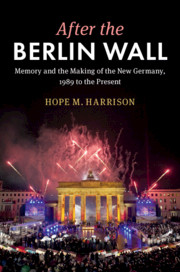Book contents
- After the Berlin Wall
- After the Berlin Wall
- Copyright page
- Dedication
- Contents
- Figures
- Acknowledgments
- Abbreviations and German Terms
- Introduction: The Berlin Wall and German Historical Memory
- 1 Divergent Approaches to the Fall of the Wall
- 2 The Fight over Memory at Bernauer Strasse
- 3 Creating a Berlin Wall Memorial Ensemble at Bernauer Strasse
- 4 Remembering the Wall at Checkpoint Charlie
- 5 The Berlin Senate’s “Master Plan for Remembering the Berlin Wall”
- 6 The Federal Government and Memory of the Berlin Wall
- 7 Victims and Perpetrators
- 8 Conflicting Narratives about the Wall
- 9 Celebrating Heroes and a New Founding Myth
- Conclusion: Memory as Warning
- SELECTED BIBLIOGRAPHY
- Index
7 - Victims and Perpetrators
Published online by Cambridge University Press: 06 September 2019
- After the Berlin Wall
- After the Berlin Wall
- Copyright page
- Dedication
- Contents
- Figures
- Acknowledgments
- Abbreviations and German Terms
- Introduction: The Berlin Wall and German Historical Memory
- 1 Divergent Approaches to the Fall of the Wall
- 2 The Fight over Memory at Bernauer Strasse
- 3 Creating a Berlin Wall Memorial Ensemble at Bernauer Strasse
- 4 Remembering the Wall at Checkpoint Charlie
- 5 The Berlin Senate’s “Master Plan for Remembering the Berlin Wall”
- 6 The Federal Government and Memory of the Berlin Wall
- 7 Victims and Perpetrators
- 8 Conflicting Narratives about the Wall
- 9 Celebrating Heroes and a New Founding Myth
- Conclusion: Memory as Warning
- SELECTED BIBLIOGRAPHY
- Index
Summary
Since the fall of the Wall, memory activists had long centered the memory of the Wall on victims, particularly those killed trying to escape. Manfred Fischer’s efforts to preserve the Wall as a “crime scene,” the erection of the Kohlhoff & Kohlhoff memorial at Bernauer Strasse, Alexandra Hildebrandt’s cemetery of crosses at Checkpoint Charlie, Berlin’s master plan (Gesamtkonzept) for remembering the Wall, and the federal government’s plan for memorials (Gedenkstättenkonzeption) were all illustrative of this focus. This would remain the case with the expansion of the Berlin Wall Memorial Site at Bernauer Strasse. Simultaneously, however, a contentious process of examining and remembering the perpetrators also took place, yet this time outside of the courtroom.
- Type
- Chapter
- Information
- After the Berlin WallMemory and the Making of the New Germany, 1989 to the Present, pp. 256 - 300Publisher: Cambridge University PressPrint publication year: 2019

